C.E. Martin's Blog, page 2
April 7, 2019
Author's Notes: Faeries, Ferrous metals, and frangible bullets
For the A to Z Blogging Challenge 2019, Punch the Rabbit delves deep behind the scenes with a series of Author's Notes related to the Stone Soldiers, Spectral Ops, and Shadow Detachment series.

Faeires, Ferrous Metals, and Frangible Bullets
What does it take to kill a fairy? They are a supernatural creature, after all. One might expect them to be immune to mortal weapons, and only vulnerable to specific substances, like the Werewolf and silver.
Before you start to ponder this, you need to step back a moment and consider what a “fairy” is. Most people probably think of Disney’s Tinkerbell, a tiny, action-figure-sized sprite who looks like she would be easily taken out with a tennis racquet or a cricket bat. But, that version of the fairy is a fairly new one. Prior to the 1800s, the Fae folk were supernatural beings of a considerably different bent. They ranged in appearance, size and friendliness--and they didn’t like iron.
I learned this bit of folklore long before Google, thanks to Marvel Comic’s Thor comic books. Back in the early 1980s, Thor and the Avengers had to prevent a Dark Elf invasion of Earth. It was a lot better than the second Thor movie of recent years, but it clearly portrayed Elves as Fae and revealed their iron weakness.
As it turns out, some mythology bears out the whole Iron-allergy thing when it comes to the Fae (some folklore doesn’t, by the way).
In writing Stone Soldiers #11, One Dark Step , where the supernatural soldiers of Detachment 1039 have to journey to the Moon to take on some Space Elves with a desire to end humanity, I had to do a lot of research into the Fae and their weaknesses. A lot of it didn’t make it into the book, but I always keep my research notes.
With the debut of the Spectral Ops sequel series to Stone Soldiers, I turned again to my notes on the supernatural and that little tidbit of folklore about iron and the Fae. As it happens, ghosts are also supposed to be allergic to iron. Some historians and folklorists will say this bit of mythology comes from the huge impact iron had on the world when mankind started to work it—that iron was a seemingly-magical metal. I suppose that works, but it’s so boring. I chose to have my series embrace iron and the Fae/Spirits the same as silver for other supernatural threats. Now, I just needed to weaponize it.
We’ve all seen silver bullets in movies before, for werewolves and other magical creatures. But what about iron bullets, I wondered one day. Well, as it turns out, the U.S. Armed Forces use steel-core ammunition for their troops (green-tipped bullets are supposed to signify a steel-core armor penetrator inside the copper-jacketed, lead bullet). But, steel isn’t pure iron. It’s iron with carbon worked into it (that was the “secret of steel” James Earl Jones’ character kept babbling about in the Conan The Barbarian movie). Maybe steel wouldn’t affect ghosts and Fae folk the same?
What about pure iron bullets?
In Episode 79 of Mythbusters, Jamie and Adam tested whether silver would make an effective metal for bullets (not just for werewolf hunting, but as the Lone Ranger’s calling cards). What they found was that silver was not a very effective metal for munitions. For one, it doesn’t deform on impact like lead, meaning it might punch through a flesh-and-blood target without losing that much of its shape or transferring all that kinetic energy into the target. A lead bullet deforms, or even breaks apart, creating a bigger wound channel in the target--it’s not only significantly cheaper, it does more damage.
Obviously, iron wouldn’t work as a solid bullet—it’s considerably tougher than silver. Even jacketed in a softer metal so it doesn’t destroy the rifling of your barrel (rifling actually scores soft metal bullets as they travel down the barrel), it will just be a low-grade armor-piercing round. Maybe great for the Fae, and maybe even an errant ghost, but what about the unintended targets that might be behind them? A standard 5.56mm NATO round, such as fired by the M-4 Carbine, will penetrate concrete blocks. A whole room full of Caspers isn't going to slow that down. Use in an area rich with civilians would no be wise.
Additionally, silver, like many other metals, shrinks when it cools. Meaning if you poured molten silver into a .45 Long Colt bullet mold, you’d end up with a smaller-diameter bullet. The rifling of the weapon it was fired out of wouldn’t be able to impart the spin on the projectile that ensures accuracy. That means a silver bullet has to be cast larger, then machined or ground down to .45 caliber diameter.
Myself and other authors have solved this problem in fiction by having silver-impregnated lead bullets—you just put slivers, flecks, or particles of silver into molten lead when you cast your ammo. When the lead cools, it stays the right size and now has pre-made silver shrapnel inside it. When the bullet breaks up in the target, it spreads the silver around.
I briefly considered iron-impregnated lead bullets for the Spectral Ops series, but to my great surprise, found there already are iron bullets available on the consumer market.
Frangible (meaning brittle or fragile) bullets are projectiles made to disintegrate on impact. These are great if you’re shooting at steel targets. Steel targets last considerably longer than paper or cardboard ones, plus they make a satisfying sound when hit. The danger with a steel target is that even fragments of soft lead (and slightly-harder copper jackets) can ricochet off the steel, traveling back toward a target shooter. Frangible rounds are made of compressed metal powders (usually copper) that explode in a spray of specks when they hit a hard surface.
This was perfect. Imagine the team is fighting a ghost army in a populated area. They fire a few shots, pushing what amounts to a plug of iron powder through the targets, disrupting them. The bullets continue on and hit a wall. Instead of puncturing the wall like a typical copper-jacketed lead round, the bullet would instead fragment apart. This would be even more effective against the Fae folk, as an iron frangible bullet would break into a lot of tiny shrapnel inside the wound. It’d be like pouring super-salt into a regular wound.
If you’re wondering why anyone would make an iron powder bullet in the real world, you needn’t worry. It’s not about a war against Fairy folk. Iron is not just non-toxic (unlike lead) but it is considerably cheaper than copper. At least, that’s the official reason given…
Technical Note: Some reviewers of frangibles warn that the crumbly bullets don't feed properly in semi-automatic weapons and are better used in revolvers, breech-loaders, and the like.

Faeires, Ferrous Metals, and Frangible Bullets
What does it take to kill a fairy? They are a supernatural creature, after all. One might expect them to be immune to mortal weapons, and only vulnerable to specific substances, like the Werewolf and silver.
Before you start to ponder this, you need to step back a moment and consider what a “fairy” is. Most people probably think of Disney’s Tinkerbell, a tiny, action-figure-sized sprite who looks like she would be easily taken out with a tennis racquet or a cricket bat. But, that version of the fairy is a fairly new one. Prior to the 1800s, the Fae folk were supernatural beings of a considerably different bent. They ranged in appearance, size and friendliness--and they didn’t like iron.
I learned this bit of folklore long before Google, thanks to Marvel Comic’s Thor comic books. Back in the early 1980s, Thor and the Avengers had to prevent a Dark Elf invasion of Earth. It was a lot better than the second Thor movie of recent years, but it clearly portrayed Elves as Fae and revealed their iron weakness.
As it turns out, some mythology bears out the whole Iron-allergy thing when it comes to the Fae (some folklore doesn’t, by the way).
In writing Stone Soldiers #11, One Dark Step , where the supernatural soldiers of Detachment 1039 have to journey to the Moon to take on some Space Elves with a desire to end humanity, I had to do a lot of research into the Fae and their weaknesses. A lot of it didn’t make it into the book, but I always keep my research notes.
With the debut of the Spectral Ops sequel series to Stone Soldiers, I turned again to my notes on the supernatural and that little tidbit of folklore about iron and the Fae. As it happens, ghosts are also supposed to be allergic to iron. Some historians and folklorists will say this bit of mythology comes from the huge impact iron had on the world when mankind started to work it—that iron was a seemingly-magical metal. I suppose that works, but it’s so boring. I chose to have my series embrace iron and the Fae/Spirits the same as silver for other supernatural threats. Now, I just needed to weaponize it.
We’ve all seen silver bullets in movies before, for werewolves and other magical creatures. But what about iron bullets, I wondered one day. Well, as it turns out, the U.S. Armed Forces use steel-core ammunition for their troops (green-tipped bullets are supposed to signify a steel-core armor penetrator inside the copper-jacketed, lead bullet). But, steel isn’t pure iron. It’s iron with carbon worked into it (that was the “secret of steel” James Earl Jones’ character kept babbling about in the Conan The Barbarian movie). Maybe steel wouldn’t affect ghosts and Fae folk the same?
What about pure iron bullets?
In Episode 79 of Mythbusters, Jamie and Adam tested whether silver would make an effective metal for bullets (not just for werewolf hunting, but as the Lone Ranger’s calling cards). What they found was that silver was not a very effective metal for munitions. For one, it doesn’t deform on impact like lead, meaning it might punch through a flesh-and-blood target without losing that much of its shape or transferring all that kinetic energy into the target. A lead bullet deforms, or even breaks apart, creating a bigger wound channel in the target--it’s not only significantly cheaper, it does more damage.
Obviously, iron wouldn’t work as a solid bullet—it’s considerably tougher than silver. Even jacketed in a softer metal so it doesn’t destroy the rifling of your barrel (rifling actually scores soft metal bullets as they travel down the barrel), it will just be a low-grade armor-piercing round. Maybe great for the Fae, and maybe even an errant ghost, but what about the unintended targets that might be behind them? A standard 5.56mm NATO round, such as fired by the M-4 Carbine, will penetrate concrete blocks. A whole room full of Caspers isn't going to slow that down. Use in an area rich with civilians would no be wise.
Additionally, silver, like many other metals, shrinks when it cools. Meaning if you poured molten silver into a .45 Long Colt bullet mold, you’d end up with a smaller-diameter bullet. The rifling of the weapon it was fired out of wouldn’t be able to impart the spin on the projectile that ensures accuracy. That means a silver bullet has to be cast larger, then machined or ground down to .45 caliber diameter.
Myself and other authors have solved this problem in fiction by having silver-impregnated lead bullets—you just put slivers, flecks, or particles of silver into molten lead when you cast your ammo. When the lead cools, it stays the right size and now has pre-made silver shrapnel inside it. When the bullet breaks up in the target, it spreads the silver around.
I briefly considered iron-impregnated lead bullets for the Spectral Ops series, but to my great surprise, found there already are iron bullets available on the consumer market.
Frangible (meaning brittle or fragile) bullets are projectiles made to disintegrate on impact. These are great if you’re shooting at steel targets. Steel targets last considerably longer than paper or cardboard ones, plus they make a satisfying sound when hit. The danger with a steel target is that even fragments of soft lead (and slightly-harder copper jackets) can ricochet off the steel, traveling back toward a target shooter. Frangible rounds are made of compressed metal powders (usually copper) that explode in a spray of specks when they hit a hard surface.
This was perfect. Imagine the team is fighting a ghost army in a populated area. They fire a few shots, pushing what amounts to a plug of iron powder through the targets, disrupting them. The bullets continue on and hit a wall. Instead of puncturing the wall like a typical copper-jacketed lead round, the bullet would instead fragment apart. This would be even more effective against the Fae folk, as an iron frangible bullet would break into a lot of tiny shrapnel inside the wound. It’d be like pouring super-salt into a regular wound.
If you’re wondering why anyone would make an iron powder bullet in the real world, you needn’t worry. It’s not about a war against Fairy folk. Iron is not just non-toxic (unlike lead) but it is considerably cheaper than copper. At least, that’s the official reason given…
Technical Note: Some reviewers of frangibles warn that the crumbly bullets don't feed properly in semi-automatic weapons and are better used in revolvers, breech-loaders, and the like.
Published on April 07, 2019 17:51
April 5, 2019
Author's Notes: El--Discovering Superman's divinity
For the A to Z Blogging Challenge 2019, Punch the Rabbit delves deep behind the scenes with a series of Author's Notes related to the Stone Soldiers, Spectral Ops, and Shadow Detachment series.

You don’t have to watch the CW’s Supernatural to notice that a lot of angel names end in “el”. Even the word Angelhas an el in it. I never gave this much thought, until I had to do research on fallen angel names for the main villain of Stone Soldiers #13, Shadow Raiders—a fallen angel ruling the alternate reality Earth of the book.
In the course of reading about angels and those named both in the Bible and in Judiasm and Kabbalah, I stumbled across something, really, really interesting: El.
To back up a moment, the first time I ever heard “el” was the car-truck hybrid of the 1970s: the el camino, which translates to “the road”. The Biblical “el” is considerably different.
Michael, Gabriel, Uriel, Raphael.. so many angels, all with “el”. The answer is really simple: “el”, in this context, means “of god”.
Now, not all angel names have “el” in them; Samyaza, Armaros, Mastema are examples of el-less names. And then, there’s Kal-el.
Whoa, wait… what?
That’s right, the last son of Krypton comes from the House of El, the same as his father, Jor-El.
Is this a coincidence? Well, if we look at Superman’s creators, Jerry Siegel and Joe Shuster, we learn that Mr. Siegel was the son of Jewish immigrants who had fled Lithuania. Mr. Shuster also came from a Jewish family.
I’ll note, at this point, that “El” means “God”. Meaning that the House of El, is the House of God, and that Superman, perhaps in the eyes of his creators, was a servant of God.
I’d say “Holy Moly!”, but that’s Shazam’s line.
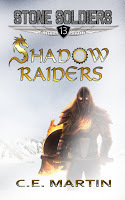
You can read about the Fallen Angel Aurg-El and the alternate reality Asgard in Stone Soldiers #13, Shadow Raiders, available now on Kindle.
Published on April 05, 2019 09:00
April 4, 2019
Author's Notes: The Djinn
For the A to Z Blogging Challenge 2019, Punch the Rabbit delves deep behind the scenes with a series of Author's Notes related to the Stone Soldiers, Spectral Ops, and Shadow Detachment series.

This summer, Will Smith comes to the big screen as the jovial, magical blue being known simply as “Genie” in Disney’s live action version of the animated classic “Aladdin”. While it’ll most likely be a fun movie filled with humor and big budget special effects, it isn’t exactly accurate when it comes to Genie.
The term Genie actually comes from much older name—Djinn (or Jinn)—referring to a supernatural being of the Middle East that can mean spirit or demon, depending on the source material.
I first began researching the topic of Djinn (a singular and plural term) several years ago when I was writing a prequel short story to the Stone Soldiers series, Catching Fire.The story centers around Daniel Smith, a resurrected U.S. soldier who returns to the Middle East a new, supernatural man, to investigate reports of living fire attacking American bases in Afghanistan.
For the story, I wanted to try and use some Arabic folklore concerning fire elementals—Catching Firewas to be one of four stories pitting the supernatural soldiers of Detachment 1039 against nature spirits. What I found when I was Googling the subject was a lot of information about the Djinn.
First off, Djinn aren’t blue-skinned, cheerful beings trapped in magic lamps, waiting to be set free and do the magical bidding of humans. One explanation for the origin of the word Djinn (Jinn) is that it comes from the Semitic root jnn (Arabic: جَنّ / جُنّ, jann), and means "to hide" or "to conceal". Some scholarly types have taken this to mean that the Djinn are, literally, "beings that are concealed from the senses".
Alternative theories are that this is a word derived from Persia—and the word "Jaini", which was a wicked (female) spirit.
In Pre-Islamic Persia, Djinn were apparently worshipped, but were not considered immortal, like the gods. The term was also used for a variety of supernatural entities, including demons.
In the course of reading about the Djinn, I learned that some folklore had there being good and bad Djinn. And that some Djinn were invisible, while others appeared as flame, and others as thick smoke. But the best thing I learned doing this research, was the story of Solomon’s seal.
Solomon, a Biblical King, is said to have received a special seal from God, which he branded a demon with, making it his slave. Solomon then ordered the demon to take the seal and go brand others of its kind, creating an army of supernatural being all bowing down to Solomon… who made them build a Temple to God.
Now, this story immediately resonated with me. My original concept was to have a fire elemental, or a Djinn, attacking U.S. forces. But why would it? Would sch a being even care which humans claimed to rule the sands of the Middle East? Probably not. But what if one of those humans, an insurgent, had the Seal of Solomon, and used it to bend a demon/djinn to his will? That would be a weapon that not even the U.S. Army could stand against… at least, not the conventional forces of the Army. Enter Detachment 1039, and their supernatural soldiers.
Once again, a simple supernatural concept for an action-packed story seemed to almost write itself.

You can find Stone Soldiers: Catching Fire on Kindle, or in a collection of short stories entitled Stone Soldiers: Elemental Warfare , available now on Kindle, and in Print
Published on April 04, 2019 09:00
April 3, 2019
A to Z Blogging Challenge: Centauros, Father of all Centaurs?
For the A to Z Blogging Challenge 2019, Punch the Rabbit delves deep behind the scenes with a series of Author's Notes related to the Stone Soldiers, Spectral Ops, and Shadow Detachment series.

Centauros, Father of the Centaurs
The idea was simple enough: instead of having Death ride a pale horse, have death be a pale horse. That was the genesis of Stone Soldiers #9, Pale Horseman , a story about a centaur serial killer set loose in the modern era.
Of course, before writing about anything, and in particular mythology, it’s always a good idea to do research and not just go by memory—which is often tainted by the fictional works of others. Thus, I set out on the internet, to research centaurs—their origins, their history, their folklore. I was very surprised at what I found.
Now, I remembered that the myth of centaurs was purported by scholars to be the result of the first sightings of men riding horses—the concept was so foreign, people invented stories of half-man, half-horse creatures.
However, it turns out that there is another explanation for centaurs—Greek Mythology that doesn’t just explain the race of the centaur, but that actually details the creation of the first man-horse.
As the story goes, Ixion, King of the Lapiths (a legendary tribe noted for their horsemanship), murdered his father-in-law after a deal gone wrong, and was driven mad with guilt. Taking pity on Ixion, Zeus brought him to Olympus. There, Ixion took a liking to Hera, Zeus’ wife. Angered, Zeus then made a cloud into the form of Hera (named Nephele), and tricked Ixion into mating with it. Their offspring was Centauros, a deformed man who eventually turned to horses for companionship after being shunned by humanity, and sired the race of the centaur.
Now, this bit of Greek mythology is just as gross and disturbing as any other tale, but it got me thinking about the idea of a cursed Centaur. What if the centaur of Pale Horseman wasn’t the bloodthirsty, millennia-old serial killer of my story, but rather was a victim of a curse?
What the heck, it was worth a try, so I turned back to more Greek mythology for inspiration, and did some reading about Charon, the traditional walking, talking skeleton associated with our image of Death.
In mythology, Charon is the ferryman of the dead, an animated skeleton that takes the worthy across the river Styx. Alas, the spooky skeleton I always thought of when I heard this bit of lore isn’t the traditional form of Charon. Instead, the ferryman appears on some art as a humanish-looking brute. In other works, he is described as a gaunt old man or a winged. In other words, Charon’s appearance has changed considerably from one era o another, ending up as the water-crossing version of the Grim Reaper we are all so familiar with today. And that gave me an idea…
Why not make Charon a shapechanger? Or better yet, embrace the demon portrayals, and make him able to inhabit different hosts, reshaping their flesh to suit his needs? That actually worked quite well and gave me an explanation for how my centaur-villain could have survived for so long.
So, from the initial concept of Centaur Serial Killer, a little research online turned my nugget of an idea into something much more complicated. And that is what always happens when you start to look deeper into folklore and mythology.
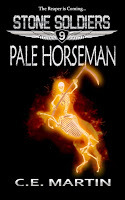
Pale Horseman (Stone Soldiers #9)Available now on Kindle, and in Paperback
Published on April 03, 2019 09:00
April 2, 2019
A to Z Blogging Challenge: Bowling, KJ
For the A to Z Blogging Challenge 2019, Punch the Rabbit delves deep behind the scenes with a series of Author's Notes related to the Stone Soldiers, Spectral Ops, and Shadow Detachment series.
One of the best things about Men’s Adventure novels (a genre the Stone Soldiers books attempt to copy, in style) is the healthy dose of satire smooshed between bouts of intense, over-the-top action. Sharp-eyed readers of the series may have noticed this particular bit of satire: the Mary Cobblerbooks-within-the-books. In short, the characters of the Stone Soldiers have made references to their world’s most popular magical young adult series, about a young witch who attends a school for witches and wizard, called Frogwarts.
Yes, this is a parody of that popular real-world series about a young boy who finds out he’s something far from ordinary. How could one notinclude a reference to the successful works of a certain British author, particularly in a series that revolves around the supernatural and magical?
What readers might be surprised to learn is that there’s far more to Mary Cobbler than an off-handed character remark here and there. In fact, for the Shadow Detachment prequel short story series, I had planned an entire tome dedicated to the saga of Mary Cobbler’s author, KJ Bowling, a British author who readers would have learned wasn’t just an imaginative writer, but a former student of a witch academy herself!
Entitled Magician of Interest, this puny story was to take place in the early 2000s, just before the Stone Soldiers program, and was to feature KJ Bowling on the run from the Romanian wizards she was exposing in her children’s books. Protected by Colonel Kenslir and his A.I. sidekick MAX, the almost-witch was going to become an asset for the U.S. Military, revealing a number of secrets about the world’s many covens and the mysterious organization readers know as The Circle.
Alas, like Red Magick, the story chronologically before this one, Magician of Interest got delayed and is nothing more today than an extensive series of notes and outlines. It’s a tale of someone hiding what they really are in a series of books. And that is actually based on something in our reality.
JK Rowling’s worldwide success drew a lot of criticism when the Harry Potter novels first started coming out, with some overly-fervant Christian sects proclaiming the author was intentionally promoting witchcraft. That got me thinking… what if she really was? What if JK is a witch?
Obviously, I don’t believe Ms. Rowling is anything so evil as a bride of Satan, I do have to look to the Men’s Adventure genre, and in particular Agent 007 and wonder… You see, Ian Fleming, the author of James Bond’s many adventures, was indeed a spy himself.
If you read the biography of Ian Fleming, you’ll see the author was, beginning in 1939, a member of the British Intelligence community, serving in the British Navy, like his character Bond, and even went on to help draft plans to form the OSS—which, post-World War II, would become the CIA.
In 1953, Casino Royale was published, and James Bond became a part of literary history.
There’s an old saying that authors should write what they know. Ian Fleming did, and was highly successful. So, why not build upon that idea and choose another popular author and delve into the possibility that a witch could become an author, about witches…? Maybe in 2020...
One of the best things about Men’s Adventure novels (a genre the Stone Soldiers books attempt to copy, in style) is the healthy dose of satire smooshed between bouts of intense, over-the-top action. Sharp-eyed readers of the series may have noticed this particular bit of satire: the Mary Cobblerbooks-within-the-books. In short, the characters of the Stone Soldiers have made references to their world’s most popular magical young adult series, about a young witch who attends a school for witches and wizard, called Frogwarts.
Yes, this is a parody of that popular real-world series about a young boy who finds out he’s something far from ordinary. How could one notinclude a reference to the successful works of a certain British author, particularly in a series that revolves around the supernatural and magical?
What readers might be surprised to learn is that there’s far more to Mary Cobbler than an off-handed character remark here and there. In fact, for the Shadow Detachment prequel short story series, I had planned an entire tome dedicated to the saga of Mary Cobbler’s author, KJ Bowling, a British author who readers would have learned wasn’t just an imaginative writer, but a former student of a witch academy herself!
Entitled Magician of Interest, this puny story was to take place in the early 2000s, just before the Stone Soldiers program, and was to feature KJ Bowling on the run from the Romanian wizards she was exposing in her children’s books. Protected by Colonel Kenslir and his A.I. sidekick MAX, the almost-witch was going to become an asset for the U.S. Military, revealing a number of secrets about the world’s many covens and the mysterious organization readers know as The Circle.
Alas, like Red Magick, the story chronologically before this one, Magician of Interest got delayed and is nothing more today than an extensive series of notes and outlines. It’s a tale of someone hiding what they really are in a series of books. And that is actually based on something in our reality.
JK Rowling’s worldwide success drew a lot of criticism when the Harry Potter novels first started coming out, with some overly-fervant Christian sects proclaiming the author was intentionally promoting witchcraft. That got me thinking… what if she really was? What if JK is a witch?
Obviously, I don’t believe Ms. Rowling is anything so evil as a bride of Satan, I do have to look to the Men’s Adventure genre, and in particular Agent 007 and wonder… You see, Ian Fleming, the author of James Bond’s many adventures, was indeed a spy himself.
If you read the biography of Ian Fleming, you’ll see the author was, beginning in 1939, a member of the British Intelligence community, serving in the British Navy, like his character Bond, and even went on to help draft plans to form the OSS—which, post-World War II, would become the CIA.
In 1953, Casino Royale was published, and James Bond became a part of literary history.
There’s an old saying that authors should write what they know. Ian Fleming did, and was highly successful. So, why not build upon that idea and choose another popular author and delve into the possibility that a witch could become an author, about witches…? Maybe in 2020...
Published on April 02, 2019 09:00
April 1, 2019
A to Z Blogging Challenge: Author's Notes and the Almas
It’s April, 2019, and it’s once again time for daily, letter-themed posts. Instead of trying to find people, places and things from the Stone Soldiers universe, I’m going to do something different this year. I’m going to take readers behind the scenes and share some of the cool stuff that didn’t make it into any of the books. Most of this stuff is actually from folklore—tidbits of this and that that I researched and studied to work into the novels. Unfortunately, not all that research ends up making the cut, and a lot of really interesting stuff gets left behind…
For today’s A-entry, I picked an easy one, the Almas. If you haven’t heard of the Almas, don’t feel bad, you’d know the creature from its more common, North American name: Bigfoot.
That’s right, ole Harry Henderson himself is How does the Almas fit into the Stone Soldiers universe? In 2016, I was working on a series of prequel short stories that showed the history of Detachment 1039 before the Stone Soldiers program—Shadow Detachment. One of the last stories I was working on was to be set in the 1981, and was to have Major Mark Kenslir going behind the Iron Curtain to steal the Head of Medusa from the Soviets. Yes, it's a supernatural version of the classic Clint Eastwood Cold War film, Firefox ...
While the story, Red Magick, was to feature the infamous Rasputin (surviving into the modern era thanks to magic), I felt it needed something more. Looking into Soviet and Russian folklore, I stumbled across the Almas (Bigfoot in Russia), Stalin’s experiments to put human heads on gorilla bodies, and the Dog-faced men of Eastern Europe. It all seemed to go together and I set out to finish the story…
...Which just kept getting delayed and delayed. Maybe one day, I’ll finish it, but for readers of the series who might have wondered where Bigfoot is in a supernatural series featuring so many modern myths, have no fear—Bigfoot is out there, in multiple places around the world.
And while you’re waiting for the next Stone Soldiers/Spectral Ops installment, maybe you might want to check out Rasputin, Dog-faced men, Stalin’s super soldiers experiments, and of course, the Almas.
Published on April 01, 2019 18:52
December 29, 2018
RABBIT PUNCH: 2019
After a one year hiatus, the Stone Soldiers of Detachment 1039, the Shadow Detachment are coming back!
Coming in January 2019, the dark war against the supernatural continues with Island of the Damned
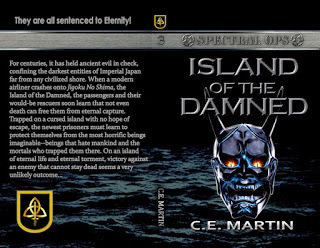
In March 2019, readers take a trip back to the early days of the Detachment, before Stone Soldiers, with a special trip behind the Iron Curtain in Red Magick...
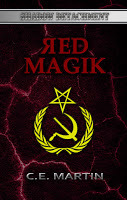
Coming in January 2019, the dark war against the supernatural continues with Island of the Damned

In March 2019, readers take a trip back to the early days of the Detachment, before Stone Soldiers, with a special trip behind the Iron Curtain in Red Magick...

Published on December 29, 2018 10:56
April 9, 2018
Book of Stone: Carrie Huston
A lower-level witch cast out of her coven, Carrie Huston turned to researching the past to find a way to exact revenge on her peers. During the course of her studies, she stumbled across an ancient secret of the Chrysanthemum throne: Jigoku No Shima, a prison for the supernatural monsters of Japan.
After months of study. Huston managed to determine the location of the island and set out to reach it and use the many demons imprisoned there against the witches who betrayed her. Manipulating the flight crew of a passenger bound for Australia, Huston crashed the plane on Jigoku No Shima, intending to use the souls of the passengers to provide her the power she needed to enslave the demons trapped on the island.
Huston’s plans were ultimately derailed by the magical safeguards of the island, its prisoners, and Detachment 1039.
Read more about Carrie Huston and Jigoku No Shima in Spectral Ops #3, Island of the Damned, coming Fall 2018.
Published on April 09, 2018 18:18
Book of Stone: Gunpowder
First appearing in the American Southwest in early 1990, the drug gunpowder—so-called for its black coloration—originated in South America. The highly potent drug proved to be highly addictive and briefly threatened to overtake the emerging crack cocaine in illicit sales. Gunpowder’s appearance in the United States abruptly came to an end less than a year after it first appeared. Experts believed that the drug’s source was eliminated by U.S. interdiction efforts, with the remaining stockpiles smuggle din gradually used up and replaced by other more common drugs.
Behind the Scenes: Gunpowder was produced in the nation of Acre, in South America. Blended with human blood, Gunpowder was produced by alchemical means and actually linked the user with other users and the creator of the drug: the First Born Fell, son of Inti, Huayna Cuyochi. Linked, users of gunpowder could be drained of their lifeforce slowly, over time, or have their thoughts and memories read. The drug also allowed Inti to channel lifeforce into his users, giving them superhuman strengths and resistances to injury. Inti’s human underlings could further dilute the drug by adding their own blood to it, allowing the to siphon the lifeforce of those below them on the drug chain.
Gunpowder’s production was brought to a halt when Huayna was eliminated by Detachment 1039 in 1990
Read more about Gunpowder, Acre, and Huayna Cuyochi in Dark Powder, coming this Fall.
Published on April 09, 2018 17:39
April 6, 2018
Book of Stone: First Born Fell
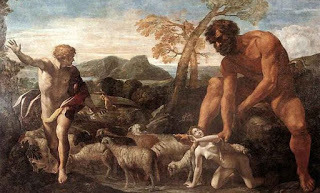
There were giants in the earth in those days; and also after that, when the sons of God came in unto the daughters of men, and they bare children to them, the same became mighty men which were of old, men of renown.--Genesis 6:4
They are a race of bastard creatures, part-man, part Fallen Angel, possessing great powers and an appetite for violence. Known in the bible as the Nephilim , or giants, these supernatural beings today are officially classified by the U.S. Military as Species-2 (which also includes their offspring, the Fell), but are more commonly referred to as "First Born Fell" or simply "First Born".
First Born vary in appearance from individual to individual. Ancient records document man instances of twelve-fingered, twelve-toed giants, with double rows of teeth and a taste or human flesh. Less humanoid appearance have been depicted as well, including a variety of creatures from mythologies around the world.
In modern times, the earliest declassified termination of a First Born occurred in Southeast Asia in 1962. At the time, the First Born was found to be bound to the service of a Chinese sorcerer aiding the Communist forces of the North Vietnamese Army. Both the sorcerer and his supernatural servant were eliminated.
Distinguishing a First Born from its Fell descendants can be particularly difficult and as yet is not clearly defined by any military standard.
Research into the First Born has revealed that the First Born have walked the Earth for millennia, interbreeding among themselves and with mortal mankind. As generations have passed, the creatures' genes have been passed on, each successive generation becoming weaker and weaker (in modern man, it is estimated nearly twelve percent of the world's population carry dormant, recessive Fell genes).
While most known First Born have been slain during the past ten centuries, there still remain an alarming number of the creatures still at large, on and off-Earth. Even more disturbing is the discovery that First Born have bred amongst themselves, creating a super-human race whose powers are only barely diminished from generation to generation.
Study of these beings ha indicated that most of the world's pantheons of non-Christian religions were in fact headed by First Born or their direct descendants.
As the progenitors of the Fell on Earth, First Born possess great powers and a nearly unlimited stamina thanks to their inherent ability to draw etheric energy from the very fabric of the universe. First Born are considered extremely dangerous and engagement with hostile First Borns is strictly prohibited by U.S. Armed forces, with the exception of Detachment 1039.
While considered nearly unstoppable, First Born are not unkillable. The first recorded death of a member of Species-2 occurred in the 19th Century in the American West, although the details and names of those involved in this encounter have been sealed under Presidential Order until the year 2399.
In 2016, Dr. [REDACTED] theorized that no Fallen Angel has walked the earth for the past two thousand years. This theory was based on the discovery of at least one Fallen Angel in the Surtr solar system. If Dr. [REDACTED]'s theory is true, the number of Species-2 appearing on Earth might be diminishing at an ever increasing rate and is believed to be completely extinguishable with adequate monitoring of extraterrestrial and extra dimensional travelers.
Published on April 06, 2018 17:58



